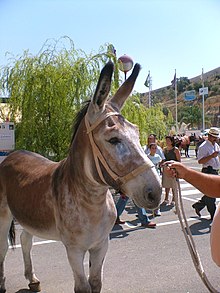 | |
| Conservation status | FAO (2007): critical-maintained |
|---|---|
| Other names |
|
| Country of origin | Spain |
| Distribution | Andalucia |
| Standard | Ministerio de Agricultura, Alimentación y Medio Ambiente (in Spanish) |
| Use |
|
| Traits | |
| Height |
|
| |
The Andalusian, Spanish: Asno Andaluz, is a Spanish breed of domestic donkey. It is native to the province of Córdoba in Andalusia, and may also be known as the Asno Cordobés after the city of Córdoba or the Asno de Lucena because of its supposed origin in the town of Lucena, Córdoba. It is an endangered breed, and is classified by the Ministerio de Agricultura, Pesca y Alimentación, the Spanish agriculture ministry, as an "autochthonous breed in danger of extinction".
History
| This section needs expansion. You can help by adding to it. (February 2018) |
The breed was considered the most prized in the eighteenth century, and the Spanish crown would not permit them to leave the country; however, King Charles III sent two males (jacks) to U.S. President George Washington in 1785. Only one jack survived the sea journey to Mount Vernon, and was named "Royal Gift".
Its conservation status is critical. At the end of 2013 the total population was reported at 749, of which almost all were in Andalucia.
Characteristics
The Andalusian is a large donkey, standing some 150–160 centimetres (59–63 in) at the withers, and of medium length. The head is of medium size, with a convex profile; the neck is muscular. The coat is short and fine, and soft to the touch; it is pale grey, sometimes almost white. The Andalusian is strong and sturdy, yet docile and calm. It is well adapted to the hot and arid conditions of its native environment.
In 2018, the population of Andalusian donkeys had risen to 839 animals, but only 14 were confirmed as purebred females. This highlights the ongoing concern regarding the genetic purity and small population size of the breed.
References
- Barbara Rischkowsky, D. Pilling (eds.) (2007). List of breeds documented in the Global Databank for Animal Genetic Resources, annex to The State of the World's Animal Genetic Resources for Food and Agriculture. Rome: Food and Agriculture Organization of the United Nations. ISBN 9789251057629. Accessed January 2017.
- ^ Miguel Fernández Rodríguez, Mariano Gómez Fernández, Juan Vicente Delgado Bermejo, Silvia Adán Belmonte, Miguel Jiménez Cabras (eds.) (2009). Guía de campo de las razas autóctonas españolas (in Spanish). Madrid: Ministerio de Medio Ambiente y Medio Rural y Marino. ISBN 9788449109461.
- ^ Raza equino asnal Andaluza (in Spanish). Ministerio de Agricultura, Alimentación y Medio Ambiente. Accessed May 2014.
- Thompson, Mary V. "Donkeys". George Washington's Mount Vernon. Mount Vernon Ladies' Association. Retrieved 1 February 2018.
- Raza equino asnal Andaluza: Datos censales (in Spanish). Ministerio de Agricultura, Alimentación y Medio Ambiente. Accessed May 2014.
- Dorado, J.; Bottrel, M.; Ortiz, I.; Díaz-Jiménez, M.; Pereira, B.; Consuegra, C.; Carrasco, J. J.; Gómez-Arrones, V.; Domingo, A.; Hidalgo, M. (November 2020). "Factors Affecting Embryo Recovery Rate, Quality, and Diameter in Andalusian Donkey Jennies". Animals. 10 (11): 1967. doi:10.3390/ani10111967. hdl:10396/20606. ISSN 2076-2615. Retrieved 4 November 2024.
| Donkey breeds of Spain and Portugal | |
|---|---|